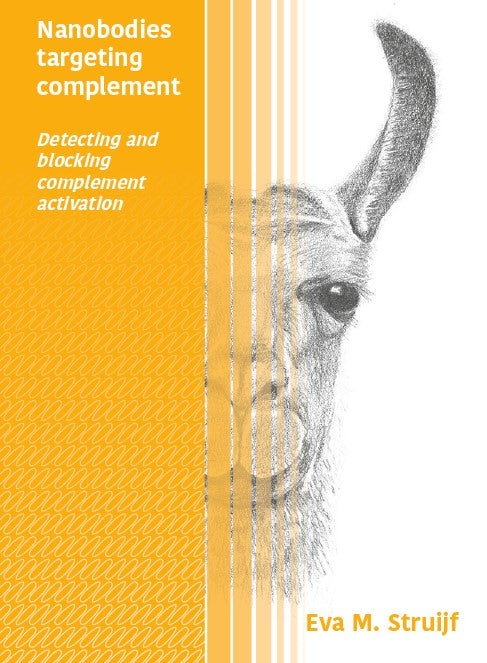Dec 1: Nanobodies identified that can modulate complement proteins

PhD research by Eva Struijf (UMC Utrecht) has identified multiple nanobodies directed towards the complement system. They prioritized four nanobodies for further characterization because of their potent binding and inhibitory activity or their unique capacity to discriminate activated complement proteins from their precursors. Nanobodies hold promise for further development as diagnostic tools and therapeutics against inflammatory and autoimmune diseases.
The complement system is an important part of the human immune system that fights invading pathogens and removes apoptotic host cells, tumor cells and immune complexes. It consists of roughly 30 proteins that circulate in the blood and other body fluids and its activity is driven by proteolytic cascades and conformational changes. The role of the complement system in health and disease is extensively being studied. Although huge progress has been made in the last decades, there are still major fundamental and clinical questions that yet remain unanswered. Overactivation of the complement system is associated with a wide variety of inflammatory and autoimmune diseases. Novel tools and therapeutics that can inhibit complement activation and that can discriminate precursor proteins from activated proteins are therefore still needed. In collaboration with Utrecht-based antibody company QVQ, PhD candidate Eva Struijf (Department of Medical Microbiology, UMC Utrecht) developed a range of llama-derived nanobodies directed towards different complement components.
Unique nanobodies identified
In her PhD thesis, Eva Struijf focused on central complement component C5 and activation products C3b and C5b6. To obtain complement targeting nanobodies, she immunized two llamas, created nanobody phage display libraries, and performed multiple rounds of phage display panning. For all complement proteins used during immunizations, Eva and her co-workers successfully identified multiple nanobodies. In the end, they prioritized four nanobodies for further characterization because of their potent binding and inhibitory activity or their unique capacity to discriminate activated complement products from their precursors. Of these four nanobodies, one was directed towards C3b, two were directed towards C5 and the last one was directed towards C5b6.

“In my thesis”, explains Eva Struijf, “we describe the development, identification and characterization of four novel anti-complement nanobodies. In doing so, we show that developing of nanobodies against complement proteins is a good approach to develop new molecules and tools. Nanobodies can be used to further address important fundamental and clinical issues related to the complement system. In addition, some of these nanobodies may have potential to be used to develop new drugs that could inhibit overactivity of the complement system.”
Complement system
The complement system is an important part of the humoral immune system that enhances the ability of antibodies and phagocytic cells to: (1) clear microbes from an organism, (2) promote inflammation to attract phagocytes, and (3) attack a pathogen's cell envelope with Membrane Attack Complex (MAC) pores. Complement proteins are mainly synthesized in the liver but can also be produced locally by immune cells, including dendritic cells, monocytes, and macrophages. Complement proteins can be recruited to the surface of bacteria and brought into action by for example antibodies that bind to these bacteria. When complement proteins are activated on the bacterial surface, they form enzymes that convert other complement proteins that release cytokines and initiate an amplifying cascade of further conversion of complement proteins. The end result is stimulation of phagocytes to clear foreign and damaged material, inflammation to attract additional phagocytes, and formation of cell-killing MAC pores in the bacterial cell wall.
Llama antibodies
In contrast to humans and other animals, llamas, camels and alpacas have a unique immune system as they produce antibodies with a single polypeptide chain instead of two. Due to their smaller size and unique chemical properties, these single-domain antibodies (also referred to as nanobodies) can access and lodge onto conventionally inaccessible regions on therapeutic targets. This makes them in particular suitable in the research for novel antibody-based diagnostics and therapies.
PhD defense

Eva Struijf (1995, Akersloot) defended her PhD thesis on November 29, 2023 at Utrecht University. The title of her thesis was “Nanobodies targeting complement – Detecting and blocking complement activation.” Supervisor was prof. Suzan Rooijakkers PhD. Co-supervisors were Bart Bardoel PhD and Dani Heesterbeek PhD (all both Department of Medical Microbiology, UMC Utrecht). This research was financially supported by an NWO TTW Industrial Doctorate grant.
